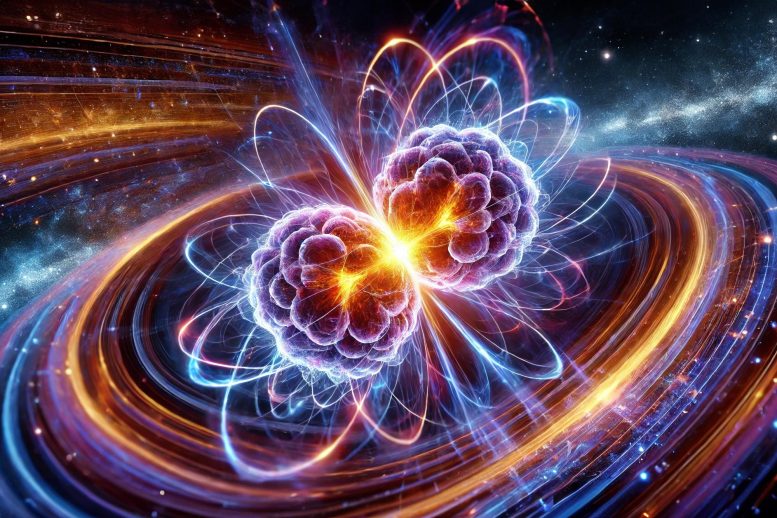
Frontiers of Physics: Nuclear Structures Revealed via Atomic Collisions

Relativistic isobar collisions have provided new insights into nuclear structures, revealing the effects of nuclear deformations on properties like multiplicity and eccentricity through advanced modeling techniques. (Artist’s concept.) Credit: SciTechDaily.com
How fluctuations and deformations influence nuclear behavior.
Researchers have uncovered detailed information about nuclear structures using relativistic isobar collisions. This study explores the subtle differences in atomic behavior, contributing to a deeper understanding of nuclear science.
A Closer Look at Nuclear Collisions
The study focused on the collisions of isobars, specifically 9644Ru+9644Ru and 9640Zr+9640Zr. These experiments revealed insights into the size and shape differences of these nuclei. Key findings include:
- Impact on Central Collisions: Initial fluctuations and nuclear deformations have minimal impact on mean multiplicity in the most central collisions.
- Effects on Eccentricity: Both factors significantly affect second- and third-order eccentricity, indicating sensitivity to underlying nuclear structures.
Shedding Light on Nuclear Structure
Isobars, nuclei with the same number of nucleons but different proton and neutron counts, have been a subject of interest for physicists. The experiments conducted by the STAR Collaboration at √sNN = 200 GeV highlighted differences in multiplicity distribution, elliptic flow, and triangular flow, leading to this detailed investigation.
Combining Advanced Models and Technology
The research employs the Optical Glauber and Monte Carlo Glauber models to analyze the effects of nuclear deformations and initial fluctuations on ratio observables. These models simulate the conditions of relativistic isobar collisions, utilizing GPU parallel computing technology to achieve high precision in calculations, especially for deformed nuclei.
Implications for Future Research
Understanding these nuclear deformations and fluctuations can advance nuclear physics and have applications in related fields. This research provides an opportunity to probe the particle production mechanisms and the underlying physics of nuclear structure.
“Our study highlights the sensitivities of various observables to nuclear deformations and initial fluctuations,” said Dr. Hao-Jie Xu, the corresponding author. “These insights could help refine particle production models and enhance our knowledge of atomic interactions.”
Future Directions
The study suggests new avenues for research in nuclear physics. The team also plans to explore final-state effects to achieve a more accurate extraction of the symmetry energy slope parameter.
In summary, this research provides valuable data on nuclear structures and paves the way for further studies in nuclear science.
Reference: “Impact of initial fluctuations and nuclear deformations in isobar collisions” by Jian-Fei Wang, Hao-Jie Xu and Fu-Qiang Wang, 4 July 2024, Nuclear Science and Techniques.
DOI: 10.1007/s41365-024-01480-8
This study is a collaborative effort between the University of Science and Technology of China, Huzhou University, and Purdue University.

